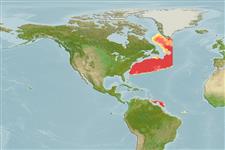Classification / Names
Common names | Synonyms | Catalog of Fishes(genus, species) | ITIS | CoL | WoRMS | Cloffa
Teleostei (teleosts) >
Lophiiformes (Anglerfishes) >
Linophrynidae (Leftvents)
Etymology: Linophryne: Greek, 'linon' = flax or anything made of flax such as "cord," "rope," or a "net" + Greek, 'phryne' = "toad" (refers to a toadlike fish that fishes with a net) (Ref. 86949).
Environment: milieu / climate zone / depth range / distribution range
Ecology
Marine; bathypelagic; depth range 620 - 1220 m (Ref. 86949). Deep-water
Northwestern Atlantic and Southeastern Indian oceans.
Size / Weight / Age
Maturity: Lm ? range ? - ? cm
Max length : 3.0 cm SL male/unsexed; (Ref. 58034); 18.5 cm SL (female)
Short description
Identification keys | Morphology | Morphometrics
Dorsal soft rays (total): 3; Anal soft rays: 3. Metamorphosed females distinguished by the following characteristics: escal bulb without distal prolongation or filaments;, absence of posterior and anterior appendages; stout, tapering filament on each side of upper part of escal bulb, each one to 1.5 times diameter of bulb; 0-2 minute conical papillae below each lateral filament; undivided primary stem of barbell, length 20-32% SL, distal end divided into a pair of short branches, each with lateral series of 3-4 long filaments, decreasing in length distally and gradually continuing as a cluster of stalked photophores on tip and medial side of each branch; each filament with distal series of internal photophores; length of proximal ang longest filaments 35-65% SL; small branch with internal photophores in cleft between pair of primary branches; dense concentration of subdermal pigment on caudal peduncle of parasitic males; parasitic males with pointed sphenotic spines (Ref. 86949).
Life cycle and mating behavior
Maturities | Reproduction | Spawnings | Egg(s) | Fecundities | Larvae
Pietsch, T.W., 2003. Linophrynidae. Netdevils (deepsea anglerfishes). p. 1069-1070. In K.E. Carpenter (ed.) FAO species identification guide for fishery purposes. The living marine resources of the Western Central Atlantic. Vol. 2: Bony fishes part 1 (Acipenseridae to Grammatidae). (Ref. 58034)
IUCN Red List Status (Ref. 130435)
Threat to humans
Harmless
Human uses
Fisheries: of no interest
Tools
Special reports
Download XML
Internet sources
Estimates based on models
Preferred temperature (Ref.
123201): 3.3 - 4, mean 3.5 °C (based on 24 cells).
Phylogenetic diversity index (Ref.
82804): PD
50 = 0.5000 [Uniqueness, from 0.5 = low to 2.0 = high].
Bayesian length-weight: a=0.01995 (0.00906 - 0.04395), b=3.01 (2.83 - 3.19), in cm total length, based on all LWR estimates for this body shape (Ref.
93245).
Trophic level (Ref.
69278): 4.0 ±0.7 se; based on size and trophs of closest relatives
Fishing Vulnerability (Ref.
59153): Low vulnerability (13 of 100).
